Project Quality Risk and Procurement Management: A Detailed Report
VerifiedAdded on 2022/08/29
|10
|2081
|18
Report
AI Summary
This report delves into the crucial aspects of project quality, risk, and procurement management. It begins with an introduction to project management, defining its core principles and the significance of quality and risk. The discussion section critically evaluates contemporary quality and risk concepts, emphasizing the importance of meeting stakeholder expectations and managing uncertain events. The report then explores the practical application of these concepts within a project environment, highlighting their impact on the project life cycle, including initiation, planning, execution, and closure. Furthermore, the report reviews best practice models, such as the Gantt chart for risk management and ISO quality management standards, to illustrate their impact on managerial decisions, such as planning, scheduling, and ensuring project success. The conclusion reinforces the importance of aligning projects with customer objectives and the role of effective quality and risk management throughout the project's duration.
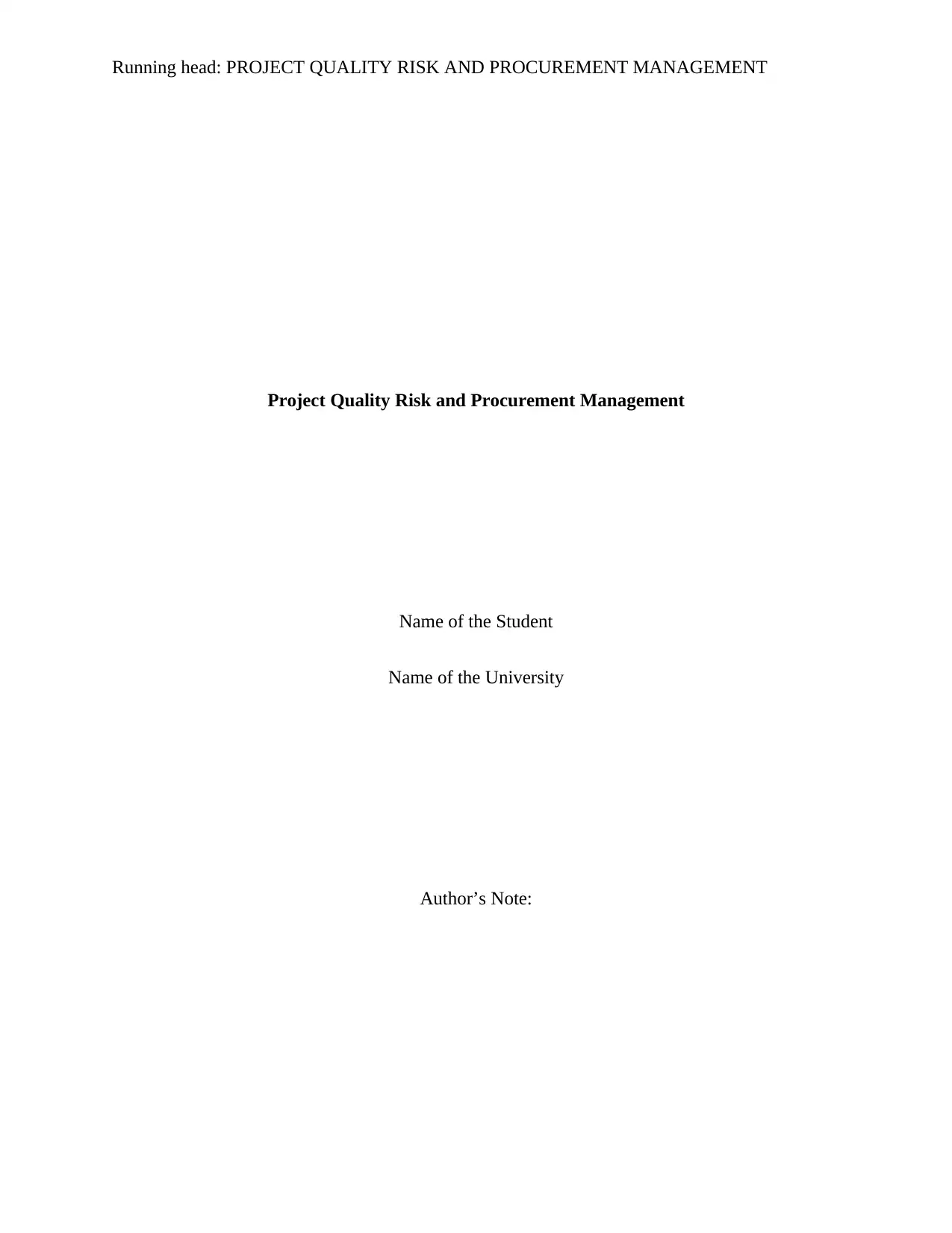
Running head: PROJECT QUALITY RISK AND PROCUREMENT MANAGEMENT
Project Quality Risk and Procurement Management
Name of the Student
Name of the University
Author’s Note:
Project Quality Risk and Procurement Management
Name of the Student
Name of the University
Author’s Note:
Paraphrase This Document
Need a fresh take? Get an instant paraphrase of this document with our AI Paraphraser
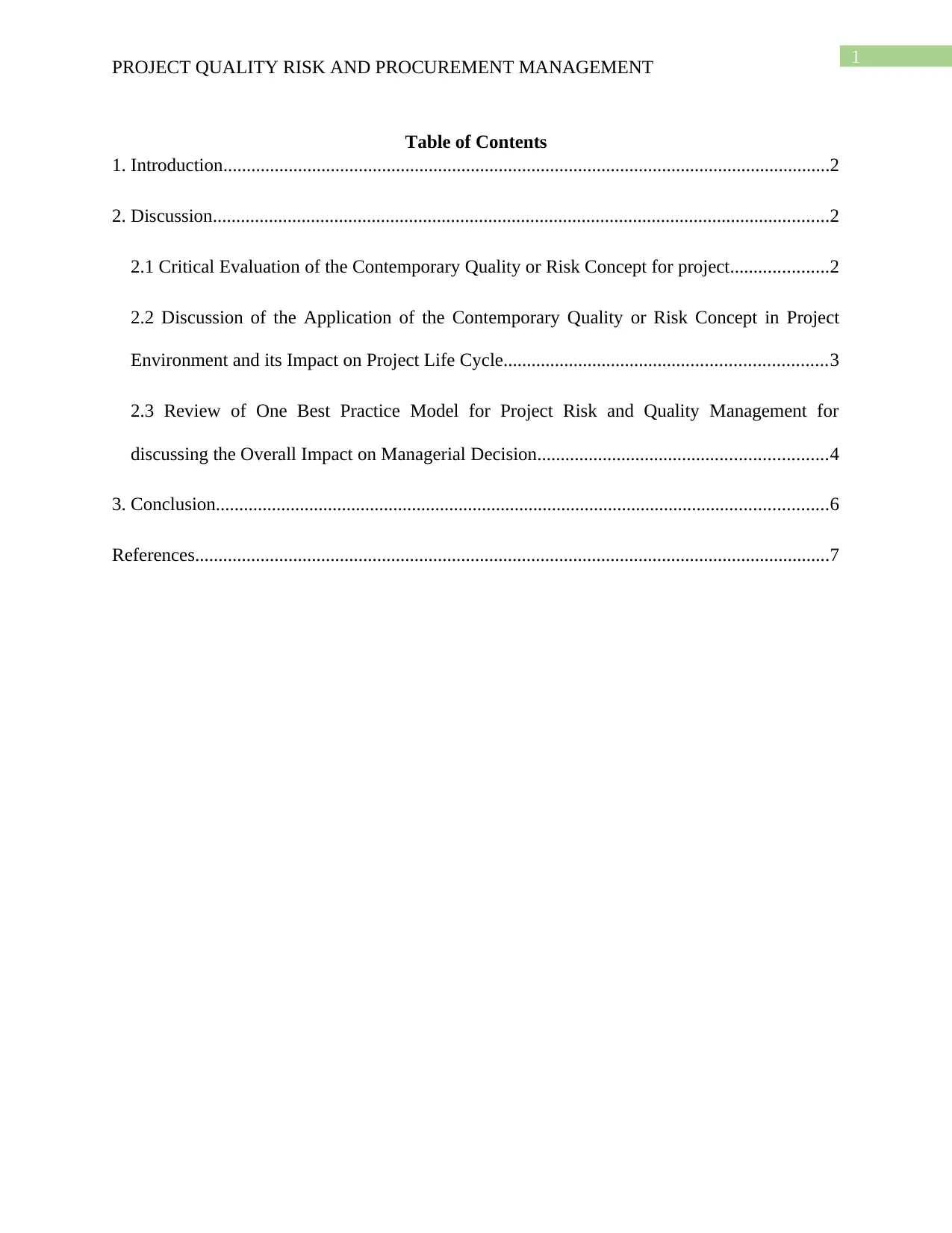
1
PROJECT QUALITY RISK AND PROCUREMENT MANAGEMENT
Table of Contents
1. Introduction..................................................................................................................................2
2. Discussion....................................................................................................................................2
2.1 Critical Evaluation of the Contemporary Quality or Risk Concept for project.....................2
2.2 Discussion of the Application of the Contemporary Quality or Risk Concept in Project
Environment and its Impact on Project Life Cycle.....................................................................3
2.3 Review of One Best Practice Model for Project Risk and Quality Management for
discussing the Overall Impact on Managerial Decision..............................................................4
3. Conclusion...................................................................................................................................6
References........................................................................................................................................7
PROJECT QUALITY RISK AND PROCUREMENT MANAGEMENT
Table of Contents
1. Introduction..................................................................................................................................2
2. Discussion....................................................................................................................................2
2.1 Critical Evaluation of the Contemporary Quality or Risk Concept for project.....................2
2.2 Discussion of the Application of the Contemporary Quality or Risk Concept in Project
Environment and its Impact on Project Life Cycle.....................................................................3
2.3 Review of One Best Practice Model for Project Risk and Quality Management for
discussing the Overall Impact on Managerial Decision..............................................................4
3. Conclusion...................................................................................................................................6
References........................................................................................................................................7
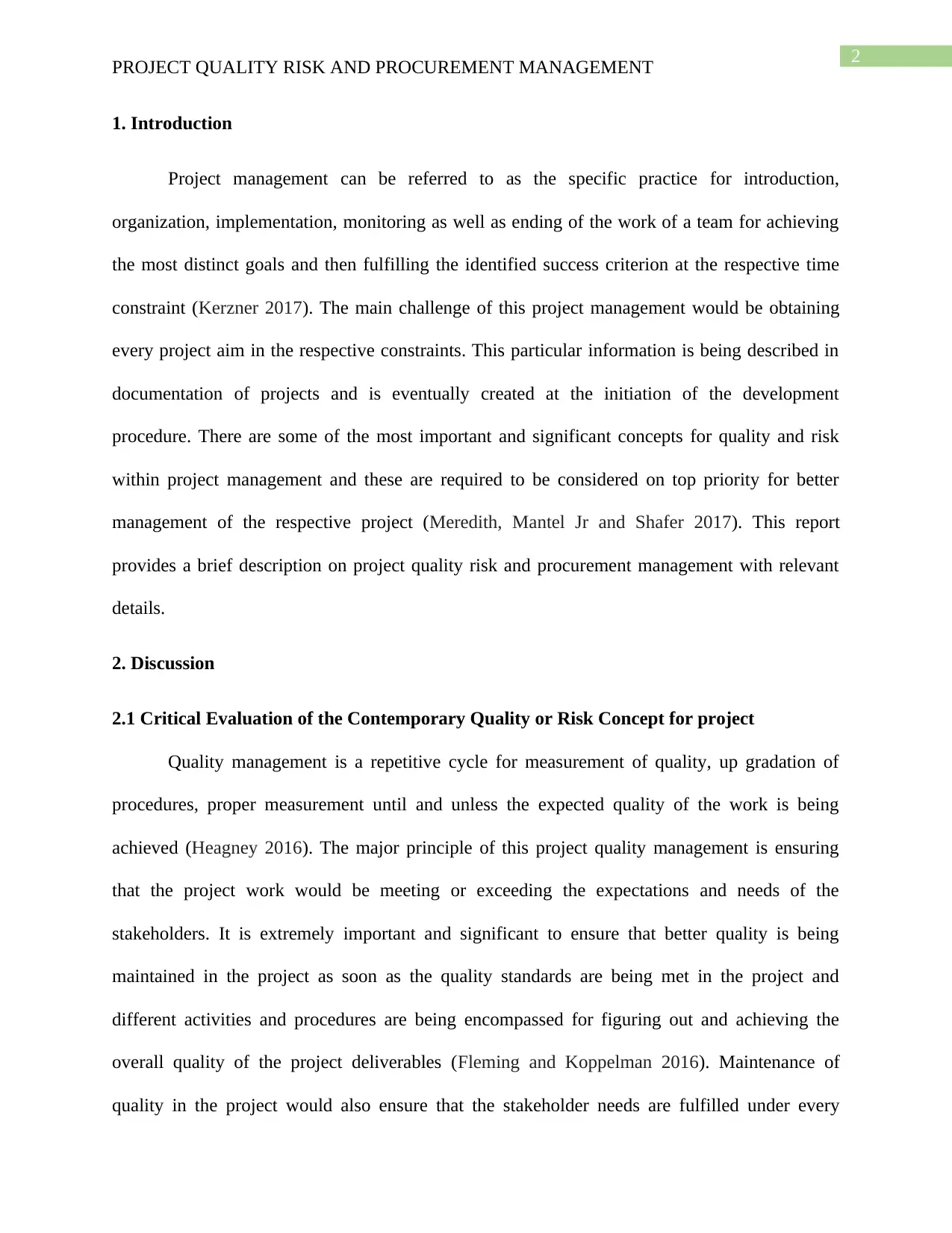
2
PROJECT QUALITY RISK AND PROCUREMENT MANAGEMENT
1. Introduction
Project management can be referred to as the specific practice for introduction,
organization, implementation, monitoring as well as ending of the work of a team for achieving
the most distinct goals and then fulfilling the identified success criterion at the respective time
constraint (Kerzner 2017). The main challenge of this project management would be obtaining
every project aim in the respective constraints. This particular information is being described in
documentation of projects and is eventually created at the initiation of the development
procedure. There are some of the most important and significant concepts for quality and risk
within project management and these are required to be considered on top priority for better
management of the respective project (Meredith, Mantel Jr and Shafer 2017). This report
provides a brief description on project quality risk and procurement management with relevant
details.
2. Discussion
2.1 Critical Evaluation of the Contemporary Quality or Risk Concept for project
Quality management is a repetitive cycle for measurement of quality, up gradation of
procedures, proper measurement until and unless the expected quality of the work is being
achieved (Heagney 2016). The major principle of this project quality management is ensuring
that the project work would be meeting or exceeding the expectations and needs of the
stakeholders. It is extremely important and significant to ensure that better quality is being
maintained in the project as soon as the quality standards are being met in the project and
different activities and procedures are being encompassed for figuring out and achieving the
overall quality of the project deliverables (Fleming and Koppelman 2016). Maintenance of
quality in the project would also ensure that the stakeholder needs are fulfilled under every
PROJECT QUALITY RISK AND PROCUREMENT MANAGEMENT
1. Introduction
Project management can be referred to as the specific practice for introduction,
organization, implementation, monitoring as well as ending of the work of a team for achieving
the most distinct goals and then fulfilling the identified success criterion at the respective time
constraint (Kerzner 2017). The main challenge of this project management would be obtaining
every project aim in the respective constraints. This particular information is being described in
documentation of projects and is eventually created at the initiation of the development
procedure. There are some of the most important and significant concepts for quality and risk
within project management and these are required to be considered on top priority for better
management of the respective project (Meredith, Mantel Jr and Shafer 2017). This report
provides a brief description on project quality risk and procurement management with relevant
details.
2. Discussion
2.1 Critical Evaluation of the Contemporary Quality or Risk Concept for project
Quality management is a repetitive cycle for measurement of quality, up gradation of
procedures, proper measurement until and unless the expected quality of the work is being
achieved (Heagney 2016). The major principle of this project quality management is ensuring
that the project work would be meeting or exceeding the expectations and needs of the
stakeholders. It is extremely important and significant to ensure that better quality is being
maintained in the project as soon as the quality standards are being met in the project and
different activities and procedures are being encompassed for figuring out and achieving the
overall quality of the project deliverables (Fleming and Koppelman 2016). Maintenance of
quality in the project would also ensure that the stakeholder needs are fulfilled under every
⊘ This is a preview!⊘
Do you want full access?
Subscribe today to unlock all pages.

Trusted by 1+ million students worldwide
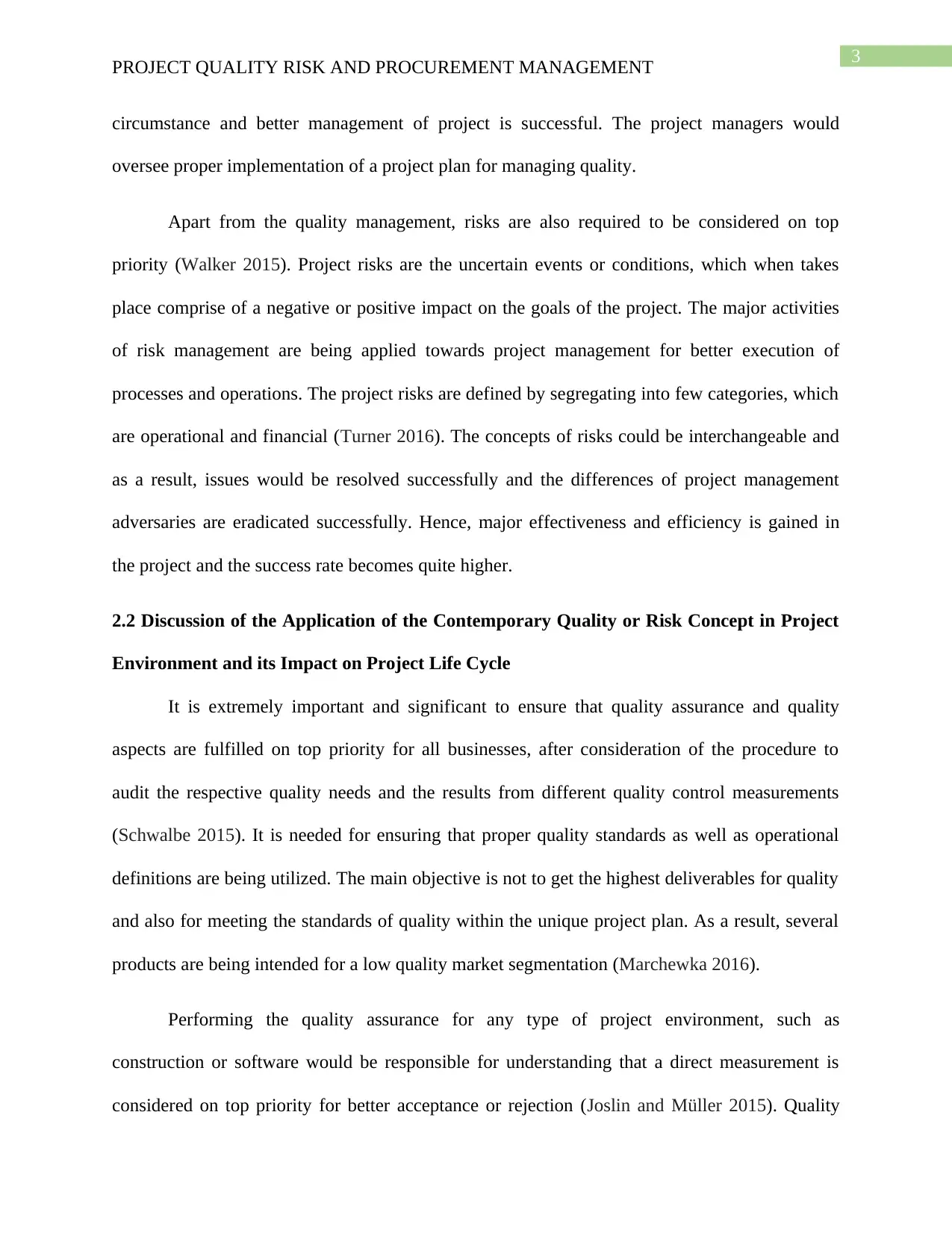
3
PROJECT QUALITY RISK AND PROCUREMENT MANAGEMENT
circumstance and better management of project is successful. The project managers would
oversee proper implementation of a project plan for managing quality.
Apart from the quality management, risks are also required to be considered on top
priority (Walker 2015). Project risks are the uncertain events or conditions, which when takes
place comprise of a negative or positive impact on the goals of the project. The major activities
of risk management are being applied towards project management for better execution of
processes and operations. The project risks are defined by segregating into few categories, which
are operational and financial (Turner 2016). The concepts of risks could be interchangeable and
as a result, issues would be resolved successfully and the differences of project management
adversaries are eradicated successfully. Hence, major effectiveness and efficiency is gained in
the project and the success rate becomes quite higher.
2.2 Discussion of the Application of the Contemporary Quality or Risk Concept in Project
Environment and its Impact on Project Life Cycle
It is extremely important and significant to ensure that quality assurance and quality
aspects are fulfilled on top priority for all businesses, after consideration of the procedure to
audit the respective quality needs and the results from different quality control measurements
(Schwalbe 2015). It is needed for ensuring that proper quality standards as well as operational
definitions are being utilized. The main objective is not to get the highest deliverables for quality
and also for meeting the standards of quality within the unique project plan. As a result, several
products are being intended for a low quality market segmentation (Marchewka 2016).
Performing the quality assurance for any type of project environment, such as
construction or software would be responsible for understanding that a direct measurement is
considered on top priority for better acceptance or rejection (Joslin and Müller 2015). Quality
PROJECT QUALITY RISK AND PROCUREMENT MANAGEMENT
circumstance and better management of project is successful. The project managers would
oversee proper implementation of a project plan for managing quality.
Apart from the quality management, risks are also required to be considered on top
priority (Walker 2015). Project risks are the uncertain events or conditions, which when takes
place comprise of a negative or positive impact on the goals of the project. The major activities
of risk management are being applied towards project management for better execution of
processes and operations. The project risks are defined by segregating into few categories, which
are operational and financial (Turner 2016). The concepts of risks could be interchangeable and
as a result, issues would be resolved successfully and the differences of project management
adversaries are eradicated successfully. Hence, major effectiveness and efficiency is gained in
the project and the success rate becomes quite higher.
2.2 Discussion of the Application of the Contemporary Quality or Risk Concept in Project
Environment and its Impact on Project Life Cycle
It is extremely important and significant to ensure that quality assurance and quality
aspects are fulfilled on top priority for all businesses, after consideration of the procedure to
audit the respective quality needs and the results from different quality control measurements
(Schwalbe 2015). It is needed for ensuring that proper quality standards as well as operational
definitions are being utilized. The main objective is not to get the highest deliverables for quality
and also for meeting the standards of quality within the unique project plan. As a result, several
products are being intended for a low quality market segmentation (Marchewka 2016).
Performing the quality assurance for any type of project environment, such as
construction or software would be responsible for understanding that a direct measurement is
considered on top priority for better acceptance or rejection (Joslin and Müller 2015). Quality
Paraphrase This Document
Need a fresh take? Get an instant paraphrase of this document with our AI Paraphraser
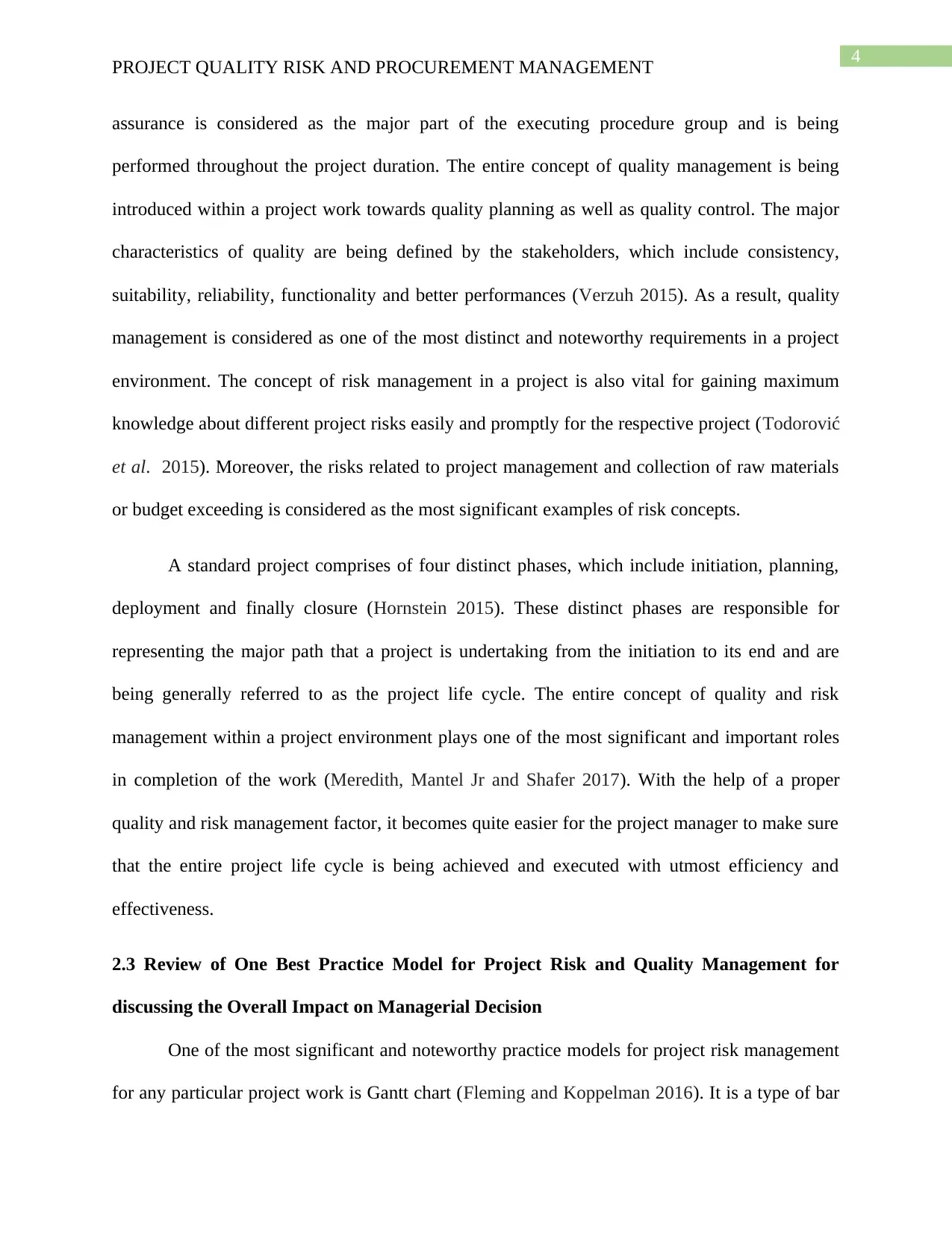
4
PROJECT QUALITY RISK AND PROCUREMENT MANAGEMENT
assurance is considered as the major part of the executing procedure group and is being
performed throughout the project duration. The entire concept of quality management is being
introduced within a project work towards quality planning as well as quality control. The major
characteristics of quality are being defined by the stakeholders, which include consistency,
suitability, reliability, functionality and better performances (Verzuh 2015). As a result, quality
management is considered as one of the most distinct and noteworthy requirements in a project
environment. The concept of risk management in a project is also vital for gaining maximum
knowledge about different project risks easily and promptly for the respective project (Todorović
et al. 2015). Moreover, the risks related to project management and collection of raw materials
or budget exceeding is considered as the most significant examples of risk concepts.
A standard project comprises of four distinct phases, which include initiation, planning,
deployment and finally closure (Hornstein 2015). These distinct phases are responsible for
representing the major path that a project is undertaking from the initiation to its end and are
being generally referred to as the project life cycle. The entire concept of quality and risk
management within a project environment plays one of the most significant and important roles
in completion of the work (Meredith, Mantel Jr and Shafer 2017). With the help of a proper
quality and risk management factor, it becomes quite easier for the project manager to make sure
that the entire project life cycle is being achieved and executed with utmost efficiency and
effectiveness.
2.3 Review of One Best Practice Model for Project Risk and Quality Management for
discussing the Overall Impact on Managerial Decision
One of the most significant and noteworthy practice models for project risk management
for any particular project work is Gantt chart (Fleming and Koppelman 2016). It is a type of bar
PROJECT QUALITY RISK AND PROCUREMENT MANAGEMENT
assurance is considered as the major part of the executing procedure group and is being
performed throughout the project duration. The entire concept of quality management is being
introduced within a project work towards quality planning as well as quality control. The major
characteristics of quality are being defined by the stakeholders, which include consistency,
suitability, reliability, functionality and better performances (Verzuh 2015). As a result, quality
management is considered as one of the most distinct and noteworthy requirements in a project
environment. The concept of risk management in a project is also vital for gaining maximum
knowledge about different project risks easily and promptly for the respective project (Todorović
et al. 2015). Moreover, the risks related to project management and collection of raw materials
or budget exceeding is considered as the most significant examples of risk concepts.
A standard project comprises of four distinct phases, which include initiation, planning,
deployment and finally closure (Hornstein 2015). These distinct phases are responsible for
representing the major path that a project is undertaking from the initiation to its end and are
being generally referred to as the project life cycle. The entire concept of quality and risk
management within a project environment plays one of the most significant and important roles
in completion of the work (Meredith, Mantel Jr and Shafer 2017). With the help of a proper
quality and risk management factor, it becomes quite easier for the project manager to make sure
that the entire project life cycle is being achieved and executed with utmost efficiency and
effectiveness.
2.3 Review of One Best Practice Model for Project Risk and Quality Management for
discussing the Overall Impact on Managerial Decision
One of the most significant and noteworthy practice models for project risk management
for any particular project work is Gantt chart (Fleming and Koppelman 2016). It is a type of bar
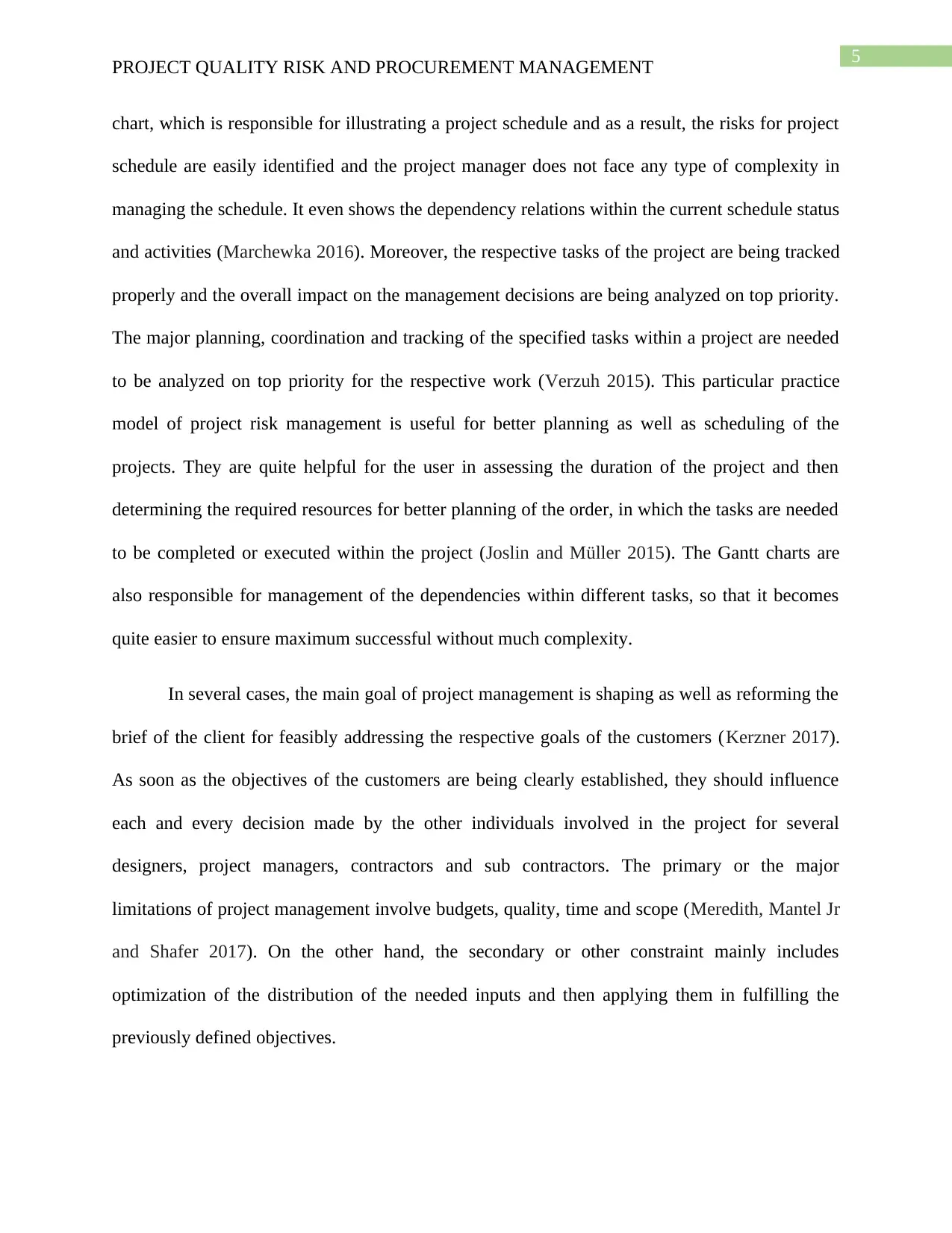
5
PROJECT QUALITY RISK AND PROCUREMENT MANAGEMENT
chart, which is responsible for illustrating a project schedule and as a result, the risks for project
schedule are easily identified and the project manager does not face any type of complexity in
managing the schedule. It even shows the dependency relations within the current schedule status
and activities (Marchewka 2016). Moreover, the respective tasks of the project are being tracked
properly and the overall impact on the management decisions are being analyzed on top priority.
The major planning, coordination and tracking of the specified tasks within a project are needed
to be analyzed on top priority for the respective work (Verzuh 2015). This particular practice
model of project risk management is useful for better planning as well as scheduling of the
projects. They are quite helpful for the user in assessing the duration of the project and then
determining the required resources for better planning of the order, in which the tasks are needed
to be completed or executed within the project (Joslin and Müller 2015). The Gantt charts are
also responsible for management of the dependencies within different tasks, so that it becomes
quite easier to ensure maximum successful without much complexity.
In several cases, the main goal of project management is shaping as well as reforming the
brief of the client for feasibly addressing the respective goals of the customers (Kerzner 2017).
As soon as the objectives of the customers are being clearly established, they should influence
each and every decision made by the other individuals involved in the project for several
designers, project managers, contractors and sub contractors. The primary or the major
limitations of project management involve budgets, quality, time and scope (Meredith, Mantel Jr
and Shafer 2017). On the other hand, the secondary or other constraint mainly includes
optimization of the distribution of the needed inputs and then applying them in fulfilling the
previously defined objectives.
PROJECT QUALITY RISK AND PROCUREMENT MANAGEMENT
chart, which is responsible for illustrating a project schedule and as a result, the risks for project
schedule are easily identified and the project manager does not face any type of complexity in
managing the schedule. It even shows the dependency relations within the current schedule status
and activities (Marchewka 2016). Moreover, the respective tasks of the project are being tracked
properly and the overall impact on the management decisions are being analyzed on top priority.
The major planning, coordination and tracking of the specified tasks within a project are needed
to be analyzed on top priority for the respective work (Verzuh 2015). This particular practice
model of project risk management is useful for better planning as well as scheduling of the
projects. They are quite helpful for the user in assessing the duration of the project and then
determining the required resources for better planning of the order, in which the tasks are needed
to be completed or executed within the project (Joslin and Müller 2015). The Gantt charts are
also responsible for management of the dependencies within different tasks, so that it becomes
quite easier to ensure maximum successful without much complexity.
In several cases, the main goal of project management is shaping as well as reforming the
brief of the client for feasibly addressing the respective goals of the customers (Kerzner 2017).
As soon as the objectives of the customers are being clearly established, they should influence
each and every decision made by the other individuals involved in the project for several
designers, project managers, contractors and sub contractors. The primary or the major
limitations of project management involve budgets, quality, time and scope (Meredith, Mantel Jr
and Shafer 2017). On the other hand, the secondary or other constraint mainly includes
optimization of the distribution of the needed inputs and then applying them in fulfilling the
previously defined objectives.
⊘ This is a preview!⊘
Do you want full access?
Subscribe today to unlock all pages.

Trusted by 1+ million students worldwide
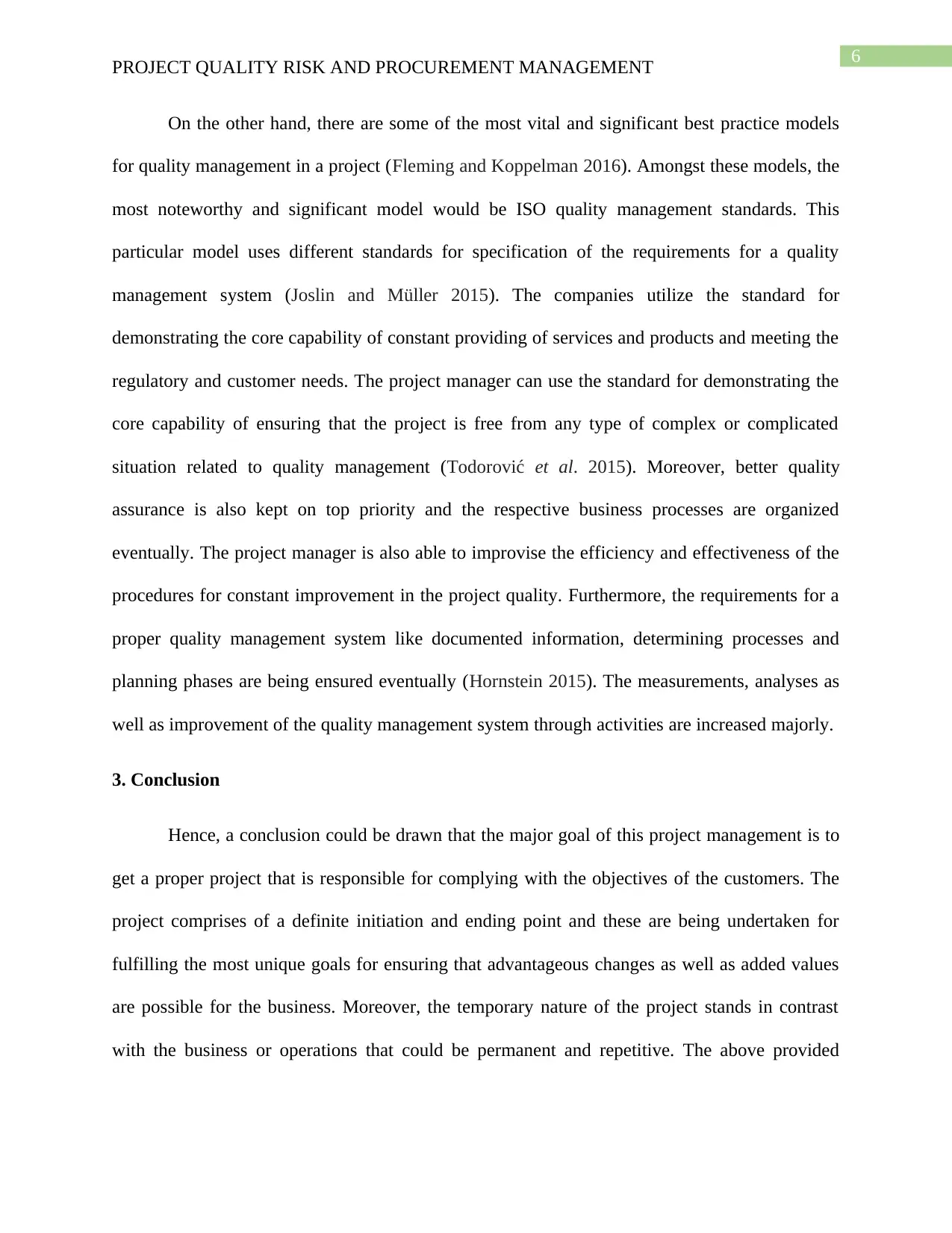
6
PROJECT QUALITY RISK AND PROCUREMENT MANAGEMENT
On the other hand, there are some of the most vital and significant best practice models
for quality management in a project (Fleming and Koppelman 2016). Amongst these models, the
most noteworthy and significant model would be ISO quality management standards. This
particular model uses different standards for specification of the requirements for a quality
management system (Joslin and Müller 2015). The companies utilize the standard for
demonstrating the core capability of constant providing of services and products and meeting the
regulatory and customer needs. The project manager can use the standard for demonstrating the
core capability of ensuring that the project is free from any type of complex or complicated
situation related to quality management (Todorović et al. 2015). Moreover, better quality
assurance is also kept on top priority and the respective business processes are organized
eventually. The project manager is also able to improvise the efficiency and effectiveness of the
procedures for constant improvement in the project quality. Furthermore, the requirements for a
proper quality management system like documented information, determining processes and
planning phases are being ensured eventually (Hornstein 2015). The measurements, analyses as
well as improvement of the quality management system through activities are increased majorly.
3. Conclusion
Hence, a conclusion could be drawn that the major goal of this project management is to
get a proper project that is responsible for complying with the objectives of the customers. The
project comprises of a definite initiation and ending point and these are being undertaken for
fulfilling the most unique goals for ensuring that advantageous changes as well as added values
are possible for the business. Moreover, the temporary nature of the project stands in contrast
with the business or operations that could be permanent and repetitive. The above provided
PROJECT QUALITY RISK AND PROCUREMENT MANAGEMENT
On the other hand, there are some of the most vital and significant best practice models
for quality management in a project (Fleming and Koppelman 2016). Amongst these models, the
most noteworthy and significant model would be ISO quality management standards. This
particular model uses different standards for specification of the requirements for a quality
management system (Joslin and Müller 2015). The companies utilize the standard for
demonstrating the core capability of constant providing of services and products and meeting the
regulatory and customer needs. The project manager can use the standard for demonstrating the
core capability of ensuring that the project is free from any type of complex or complicated
situation related to quality management (Todorović et al. 2015). Moreover, better quality
assurance is also kept on top priority and the respective business processes are organized
eventually. The project manager is also able to improvise the efficiency and effectiveness of the
procedures for constant improvement in the project quality. Furthermore, the requirements for a
proper quality management system like documented information, determining processes and
planning phases are being ensured eventually (Hornstein 2015). The measurements, analyses as
well as improvement of the quality management system through activities are increased majorly.
3. Conclusion
Hence, a conclusion could be drawn that the major goal of this project management is to
get a proper project that is responsible for complying with the objectives of the customers. The
project comprises of a definite initiation and ending point and these are being undertaken for
fulfilling the most unique goals for ensuring that advantageous changes as well as added values
are possible for the business. Moreover, the temporary nature of the project stands in contrast
with the business or operations that could be permanent and repetitive. The above provided
Paraphrase This Document
Need a fresh take? Get an instant paraphrase of this document with our AI Paraphraser
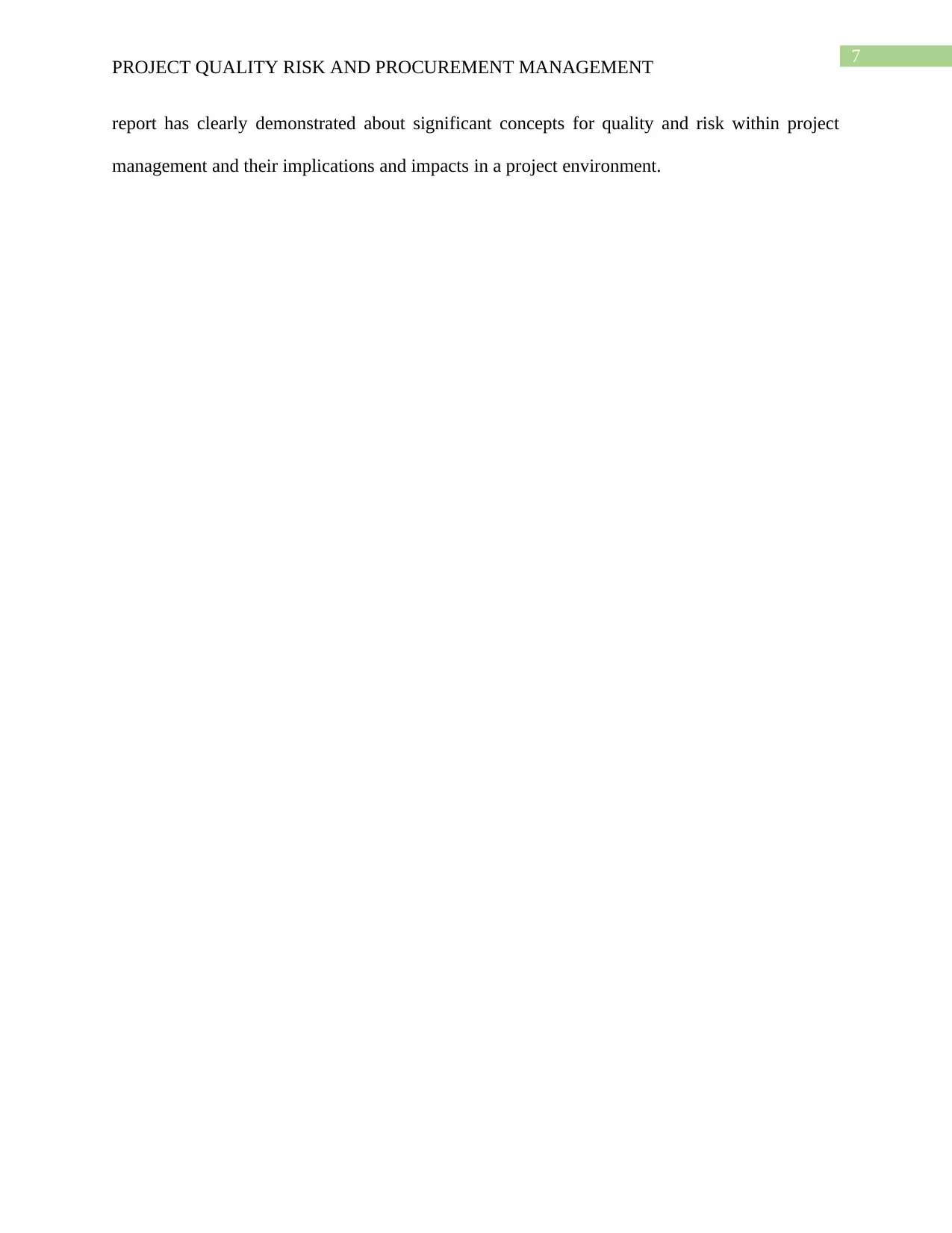
7
PROJECT QUALITY RISK AND PROCUREMENT MANAGEMENT
report has clearly demonstrated about significant concepts for quality and risk within project
management and their implications and impacts in a project environment.
PROJECT QUALITY RISK AND PROCUREMENT MANAGEMENT
report has clearly demonstrated about significant concepts for quality and risk within project
management and their implications and impacts in a project environment.
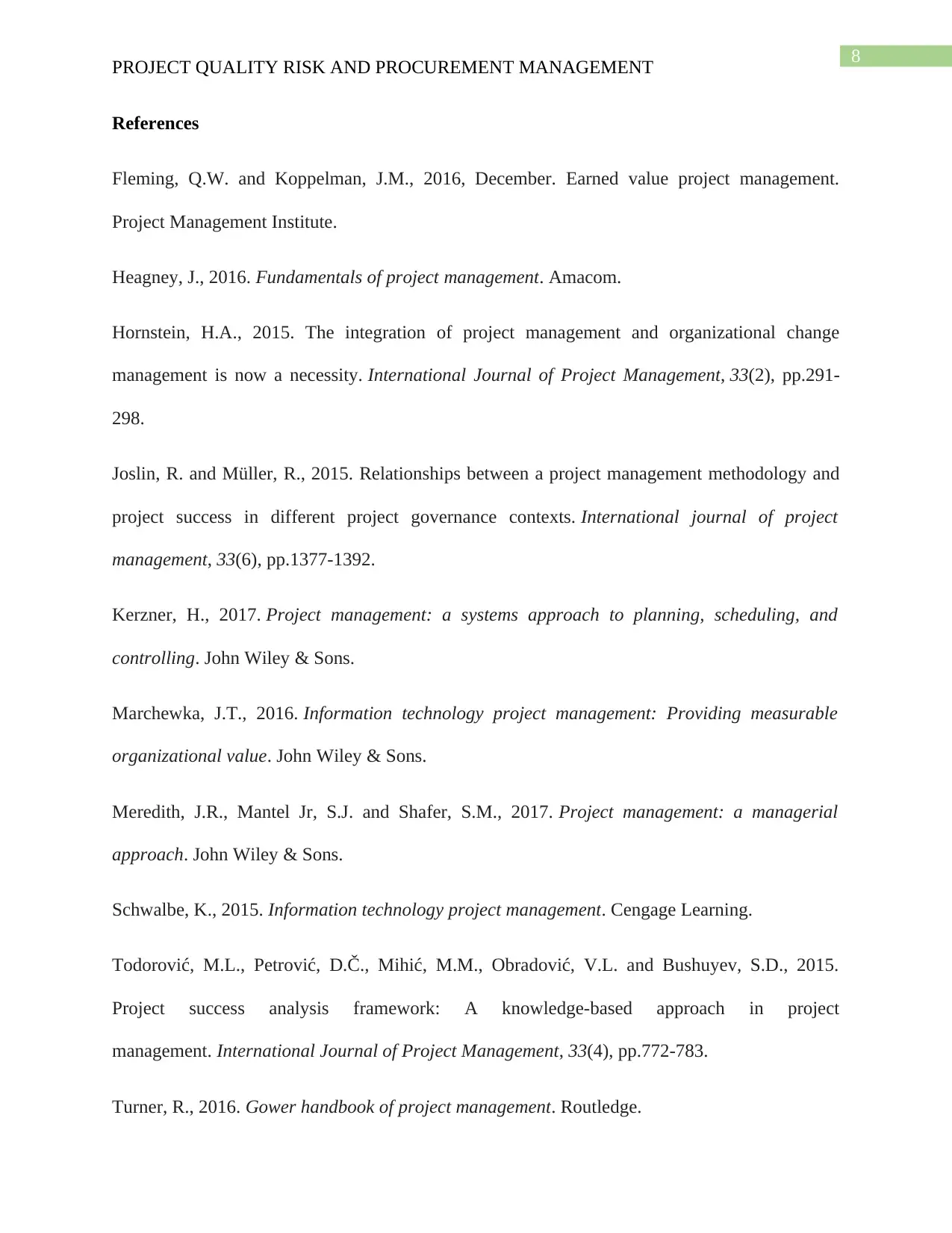
8
PROJECT QUALITY RISK AND PROCUREMENT MANAGEMENT
References
Fleming, Q.W. and Koppelman, J.M., 2016, December. Earned value project management.
Project Management Institute.
Heagney, J., 2016. Fundamentals of project management. Amacom.
Hornstein, H.A., 2015. The integration of project management and organizational change
management is now a necessity. International Journal of Project Management, 33(2), pp.291-
298.
Joslin, R. and Müller, R., 2015. Relationships between a project management methodology and
project success in different project governance contexts. International journal of project
management, 33(6), pp.1377-1392.
Kerzner, H., 2017. Project management: a systems approach to planning, scheduling, and
controlling. John Wiley & Sons.
Marchewka, J.T., 2016. Information technology project management: Providing measurable
organizational value. John Wiley & Sons.
Meredith, J.R., Mantel Jr, S.J. and Shafer, S.M., 2017. Project management: a managerial
approach. John Wiley & Sons.
Schwalbe, K., 2015. Information technology project management. Cengage Learning.
Todorović, M.L., Petrović, D.Č., Mihić, M.M., Obradović, V.L. and Bushuyev, S.D., 2015.
Project success analysis framework: A knowledge-based approach in project
management. International Journal of Project Management, 33(4), pp.772-783.
Turner, R., 2016. Gower handbook of project management. Routledge.
PROJECT QUALITY RISK AND PROCUREMENT MANAGEMENT
References
Fleming, Q.W. and Koppelman, J.M., 2016, December. Earned value project management.
Project Management Institute.
Heagney, J., 2016. Fundamentals of project management. Amacom.
Hornstein, H.A., 2015. The integration of project management and organizational change
management is now a necessity. International Journal of Project Management, 33(2), pp.291-
298.
Joslin, R. and Müller, R., 2015. Relationships between a project management methodology and
project success in different project governance contexts. International journal of project
management, 33(6), pp.1377-1392.
Kerzner, H., 2017. Project management: a systems approach to planning, scheduling, and
controlling. John Wiley & Sons.
Marchewka, J.T., 2016. Information technology project management: Providing measurable
organizational value. John Wiley & Sons.
Meredith, J.R., Mantel Jr, S.J. and Shafer, S.M., 2017. Project management: a managerial
approach. John Wiley & Sons.
Schwalbe, K., 2015. Information technology project management. Cengage Learning.
Todorović, M.L., Petrović, D.Č., Mihić, M.M., Obradović, V.L. and Bushuyev, S.D., 2015.
Project success analysis framework: A knowledge-based approach in project
management. International Journal of Project Management, 33(4), pp.772-783.
Turner, R., 2016. Gower handbook of project management. Routledge.
⊘ This is a preview!⊘
Do you want full access?
Subscribe today to unlock all pages.

Trusted by 1+ million students worldwide
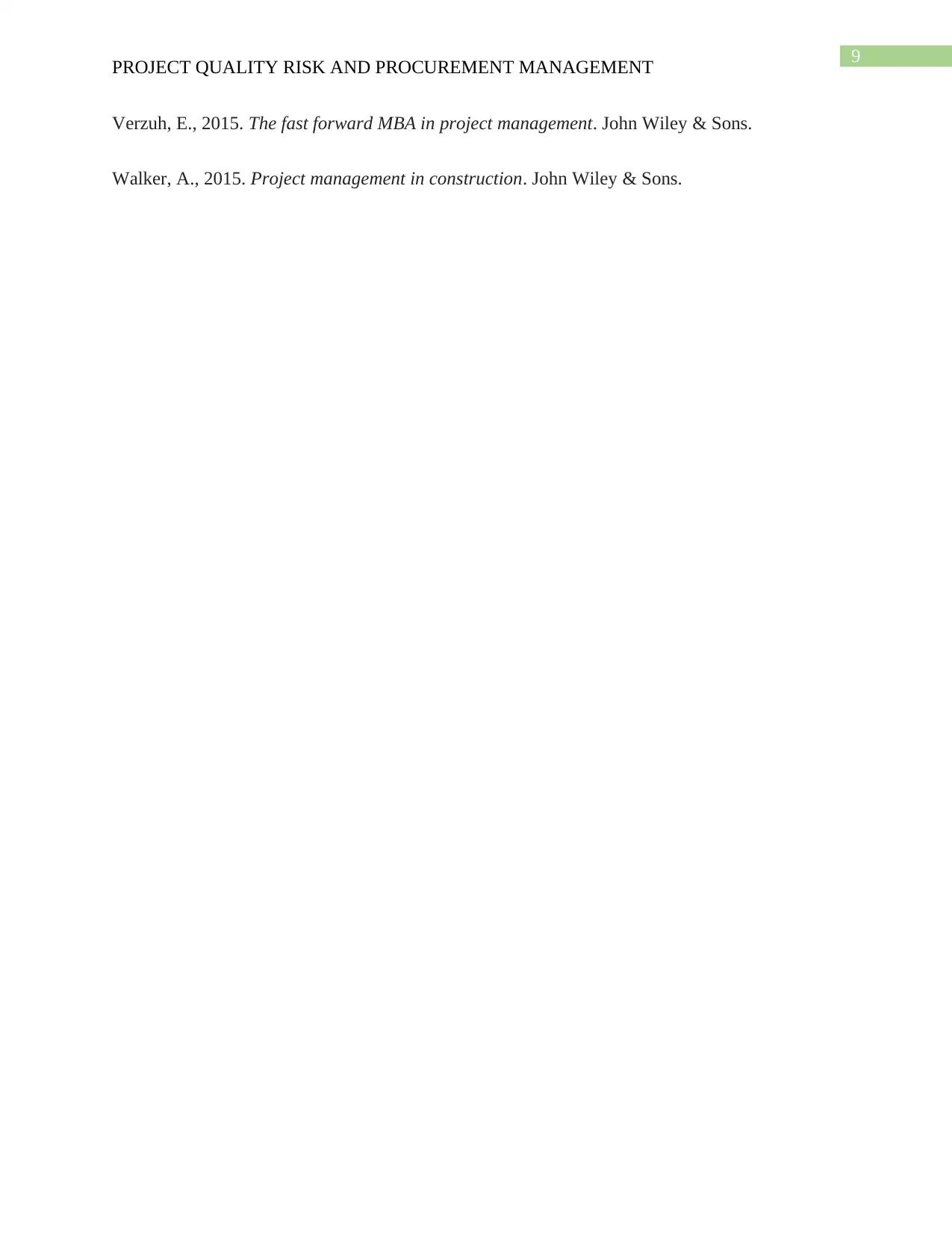
9
PROJECT QUALITY RISK AND PROCUREMENT MANAGEMENT
Verzuh, E., 2015. The fast forward MBA in project management. John Wiley & Sons.
Walker, A., 2015. Project management in construction. John Wiley & Sons.
PROJECT QUALITY RISK AND PROCUREMENT MANAGEMENT
Verzuh, E., 2015. The fast forward MBA in project management. John Wiley & Sons.
Walker, A., 2015. Project management in construction. John Wiley & Sons.
1 out of 10
Related Documents
Your All-in-One AI-Powered Toolkit for Academic Success.
+13062052269
info@desklib.com
Available 24*7 on WhatsApp / Email
![[object Object]](/_next/static/media/star-bottom.7253800d.svg)
Unlock your academic potential
Copyright © 2020–2025 A2Z Services. All Rights Reserved. Developed and managed by ZUCOL.





